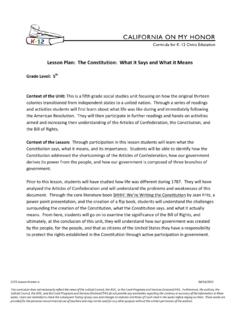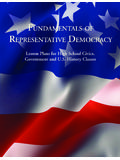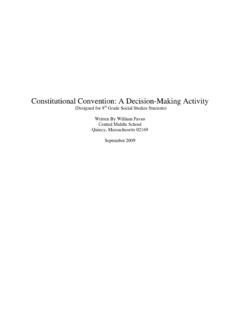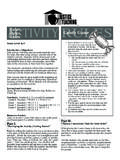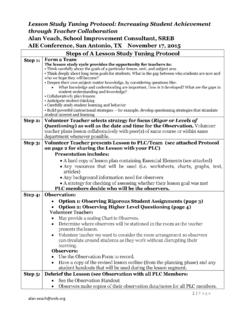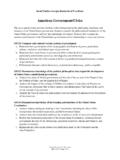Transcription of We the People Programs The Story of Ruby Bridges by …
1 We the People Programs lesson plan The Story of Ruby Bridges by Robert Coles We the People : the Citizen and the constitution Foundations of Democracy Elementary Literacy Integration lesson Purpose: The lesson is designed to integrate the concepts of civic education and civic responsibility across the curriculum using Robert Cole's book The Story of Ruby Bridges . Expectations: Students will understand the meaning of equality and how it is protected by the United States constitution . Students will demonstrate an understanding of the concepts fundamental to politics and government by identifying characters in the book that embody authority, responsibility, justice, and privacy.
2 Students will gain knowledge of Ruby Bridges and the contribution she made to the civil rights movement in the United States. Students will understand vocabulary associated with equality and civil rights. Book Summary: For months six-year-old Ruby Bridges must confront the hostility of white parents when she becomes one of the first African American girl to integrate the public schools in New Orleans in 1960. Essential Questions: How did the actions of Ruby Bridges and her family shape the history of the United States?
3 How does the United States constitution protect an individuals right to equality under the law? Does the book emphasize the concepts of civic virtue and common good? Activities: Teachers Note: Before the lesson the teacher should read The Story of Ruby Bridges by Robert Coles several times to: Become familiar with the text, Choose vocabulary words to be examined, Identify where you will stop and ask for predictions, Determine background knowledge required to fully understand the Story , Develop questions for the read aloud, and Anticipate student responses.
4 (Suggested vocabulary:Courage, Federal Marshall, Mob, Judge, Segregation, Desegregate). Reading: Before the read-aloud conduct a picture walk through the book. Cover: Ask children what comes to mind when they first look at the cover. Where do you think the girl is going? How old do you think the girl might be? What do you think the People are doing in the background. Look at the girls face. What do you suppose she is thinking? Title Page: What do you think is happening in this illustration? Where do you think the People are going?
5 Continue the picture walk through the rest of the book. Dedication Page: Ruby's mother says Our Ruby taught us all a lot. She became someone who helped change our country. She was part of history. At the end of the lesson students should be able to discuss and explain what her mother meant by these statements. Conduct an interactive read-aloud of The Story of Ruby Bridges stopping frequently to clarify what is happening in the Story and asking students to make predictions, discuss new vocabulary, and make personal connections.
6 Author study. Who was Robert Coles and what was his relationship to Ruby Bridges and her family? Social Studies: We the People : the Citizen and the constitution , Unit 4: How Does the constitution Protect Our Basic Rights? lesson 19. Introduce important terms from Unit 4: Assembly, Expression, Petition, Press, Speech, Discrimination, Tolerant, Boycott, Segregate, Civil Rights Act of 1964, Civil War Amendments, Equal Protection Clause, Equal Protection of the Laws, Fourteenth Amendment. Discuss with students how the terms are illustrated in The Story of Ruby Bridges .
7 Suggested questions for discussion include: Did the Fourteenth Amendment end discrimatory practices against African Americans? How were the Constitutional rights of Ruby Bridges and other African American children violated by the local government in New Orleans? How were freedom of speech and freedom of assembly shown in The Story of Ruby Bridges ? Foundations of Democracy Authority What characeters in the Story used authority? What characters in the Story used power with authority and where did they get their authority?
8 What characters in the Story used power without authority? The judge ordered Ruby Bridges and three other black girls to go to white elementary schools. What were some of the benefits and costs of his decision? Responsibility The President ordered Federal Marshalls to escort Ruby into the school building. What responsibilities did the Federal Marshalls have? What characters in the Story had responsibilities? Make a list of the characters and their responsibility and to whom did they owe the responsibility.
9 Did some of the characters have competing resposibilities? What were the competing responsibilities? Justice Do you think that Ruby Bridges was treated fairly in the Story ? Think about problems of Distributive Justice , problems of Corrective Justice and problems of Procedural Justice . Discuss how each of these problems of justice were demonstrated in The Story of Ruby Bridges . Do you think any of the characters in the Story should be punished for their actions? Privacy Do you think that issues related to privacy are addressed in this book?
10 Explain your answer. Writing: Students use photo analysis as a prompt for writing. Students use the district-wide writing process to complete the activity. Students select one of the three pictures below and analyze it using the Photo Anaysis Guide (The guide can be found at the end of the lesson plan ). Students should study the photograph for a minimum of 2 minutes. Students form an overall impression first and then examine the photograph for details. Suggest that students divide the photograph into four sections and study each area to see what additional details they notice.
